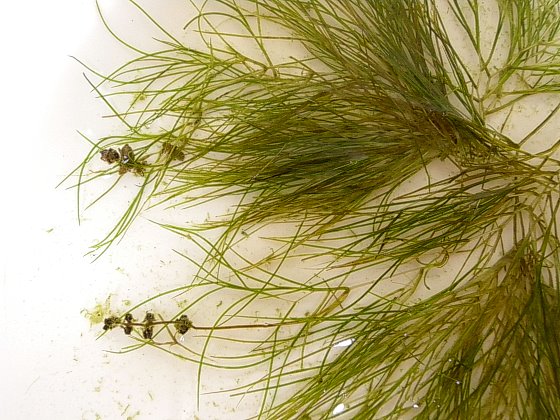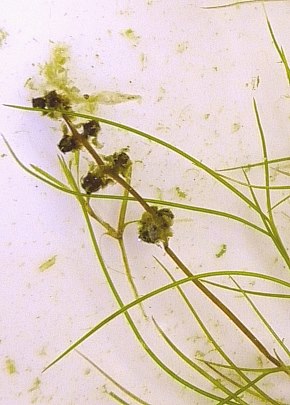
Individual spikes of flowers are produced occasionally from the axils of the leaves and the tips of outer stems on peduncles about 1½-8" long. These floral spikes are ½-1½" long, consisting of 2-6 interrupted clusters of flowers. Each greenish white flower is about 1/8" across, consisting of 4 tepals with abruptly tapered bases, 4 stamens, and a pistil with a short style. The stalk of each floral spike is light green to reddish purple, terete, and hairless. Both the floral spikes and peduncles complete their development underwater. The blooming period can occur from late spring to early fall. The submerged flowers are cross-pollinated via water. Afterwards, fertile flowers are replaced by plump achenes about 3-4 mm. long and 2.5-3.0 mm. across. These achenes are obovoid-globoid in shape and slightly compressed with small beaks at their apices. The root system is fibrous, rhizomatous, and tuberous. Clonal colonies of plants are often produced from the rhizomes.
Cultivation: The preference is full sun, shallow water up to 4' deep, and a mucky bottom. Clear water that is somewhat alkaline and calcareous is preferred, but this plant adapts to a variety of conditions, including brackish water.

Range & Habitat: The native Sago Pondweed (Stuckenia pectinata) is occasional in northern and central Illinois, becoming uncommon or absent in the southern section of the state (see Distribution Map). This aquatic plant is also found in Eurasia. Habitats include quiet inlets of lakes, ponds, reservoirs, drainage canals, and creeks with slow currents. Sometimes, Sago Pondweed becomes the dominant aquatic plant in these habitats, forming extensive colonies.
Faunal Associations: Various insects feed on the foliage or roots of Sago Pondweed (Stuckenia pectinata), or they bore into the foliage and position themselves to become filter-feeders of microscopic organisms in the water. These insect species include larvae of weevils, larvae of shore flies, larvae of long-horned caddisflies, and larvae of some Crambid moths. The Insect Table provides a more complete and detailed list of the insects that feed on various Pondweeds (Potamogeton spp.), including Sago Pondweed. The seeds, foliage, and tubers of this pondweed are eaten by many ducks and some swans – this includes such species as the Trumpeter Swan, Wood Duck, Canvasback, Mallard, Ring-necked Duck, and Lesser Scaup. The Bird Table provides a more complete list of these species. Other vertebrate animals that may feed on Sago Pondweed include muskrats and various turtles. Because Sago Pondweed often forms colonies of dense foliage, it provides good cover for many kinds of small aquatic wildlife.
Photographic Location: This plant was found in the shallow water of a pond in Champaign, Illinois.
Comments: This plant is often referred to as Potamogeton pectinatus. Two common names that are in use include Fennel-Leaf Pondweed and Comb Pondweed. The long slender leaves of Sago Pondweed tend to form dense fan-like aggregations that lie a little below the water surface. Other submerged aquatic pondweeds (Potamogeton spp.) tend to have leaves that are wider (exceeding 1.0 mm. in width) or shorter (never longer than 3" in length) and they are usually less densely aggregated. Two boreal species of the same genus, Stuckenia filiformis (Slender-Leaved Pondweed) and Stuckenia vaginata (Sheathing Pondweed), are similar to Sago Pondweed, but they have not been found in Illinois. These latter two species differ from Sago Pondweed by having 1) leaves that are sometimes wider than 1.0 mm. across, 2) leaves with obtuse tips, 3) outer stems that are less abundantly branched, and 4) achenes with either smaller beaks or no beaks.